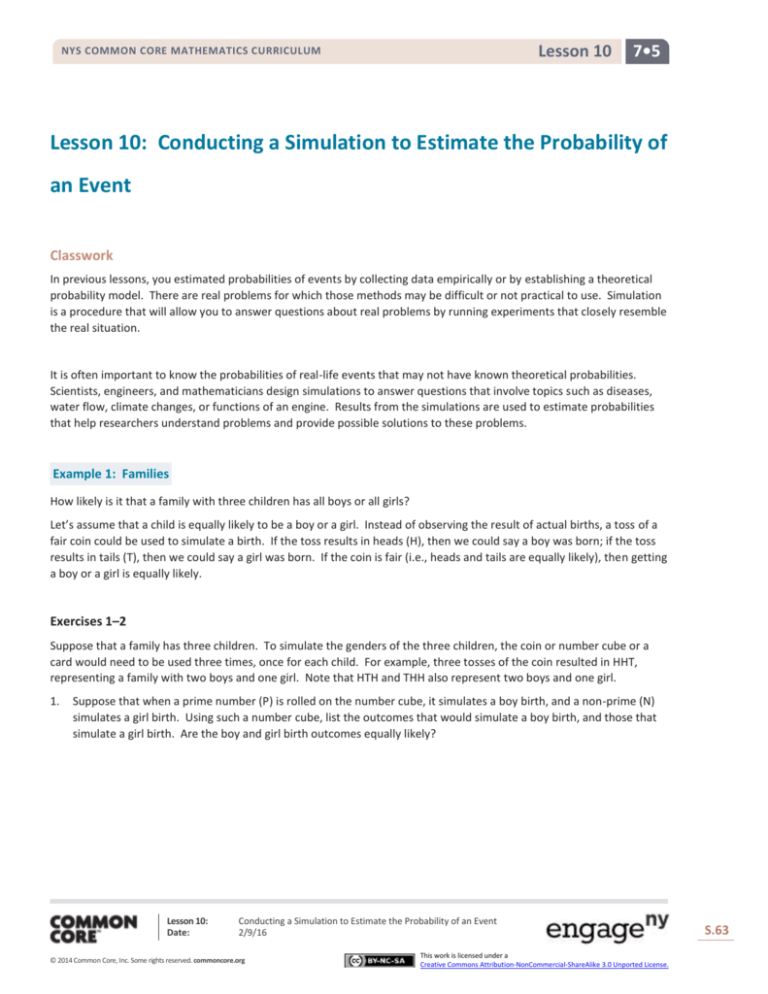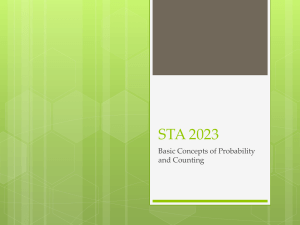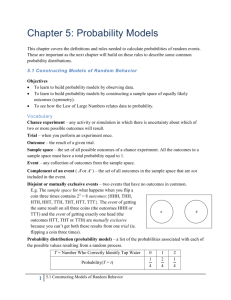
Lesson 10
NYS COMMON CORE MATHEMATICS CURRICULUM
7•5
Lesson 10: Conducting a Simulation to Estimate the Probability of
an Event
Classwork
In previous lessons, you estimated probabilities of events by collecting data empirically or by establishing a theoretical
probability model. There are real problems for which those methods may be difficult or not practical to use. Simulation
is a procedure that will allow you to answer questions about real problems by running experiments that closely resemble
the real situation.
It is often important to know the probabilities of real-life events that may not have known theoretical probabilities.
Scientists, engineers, and mathematicians design simulations to answer questions that involve topics such as diseases,
water flow, climate changes, or functions of an engine. Results from the simulations are used to estimate probabilities
that help researchers understand problems and provide possible solutions to these problems.
Example 1: Families
How likely is it that a family with three children has all boys or all girls?
Let’s assume that a child is equally likely to be a boy or a girl. Instead of observing the result of actual births, a toss of a
fair coin could be used to simulate a birth. If the toss results in heads (H), then we could say a boy was born; if the toss
results in tails (T), then we could say a girl was born. If the coin is fair (i.e., heads and tails are equally likely), then getting
a boy or a girl is equally likely.
Exercises 1–2
Suppose that a family has three children. To simulate the genders of the three children, the coin or number cube or a
card would need to be used three times, once for each child. For example, three tosses of the coin resulted in HHT,
representing a family with two boys and one girl. Note that HTH and THH also represent two boys and one girl.
1.
Suppose that when a prime number (P) is rolled on the number cube, it simulates a boy birth, and a non-prime (N)
simulates a girl birth. Using such a number cube, list the outcomes that would simulate a boy birth, and those that
simulate a girl birth. Are the boy and girl birth outcomes equally likely?
Lesson 10:
Date:
Conducting a Simulation to Estimate the Probability of an Event
2/9/16
© 2014 Common Core, Inc. Some rights reserved. commoncore.org
This work is licensed under a
Creative Commons Attribution-NonCommercial-ShareAlike 3.0 Unported License.
S.63
Lesson 10
NYS COMMON CORE MATHEMATICS CURRICULUM
2.
7•5
Suppose that one card is drawn from a regular deck of cards. A red card (R) simulates a boy birth, and a black card
(B) simulates a girl birth. Describe how a family of three children could be simulated.
Example 2
Simulation provides an estimate for the probability that a family of three children would have three boys or three girls by
performing three tosses of a fair coin many times. Each sequence of three tosses is called a trial. If a trial results in
either HHH or TTT, then the trial represents all boys or all girls, which is the event that we are interested in. These trials
would be called a success. If a trial results in any other order of H’s and T’s, then it is called a failure.
The estimate for the probability that a family has either three boys or three girls based on the simulation is the number
of successes divided by the number of trials. Suppose 100 trials are performed, and that in those 100 trials, 28 resulted
in either HHH or TTT. Then, the estimated probability that a family of three children has either three boys or three girls
28
would be
= 0.28.
100
Exercises 3–5
3.
Find an estimate of the probability that a family with three children will have exactly one girl using the following
outcomes of 50 trials of tossing a fair coin three times per trial. Use H to represent a boy birth and T to represent a
girl birth.
HHT
HTH
HHH
TTH
THT
THT
HTT
HHH
TTH
HHH
HHT
TTT
HHT
TTH
HHH
HTH
THH
TTT
THT
THT
THT
HHH
THH
HTT
HTH
TTT
HTT
HHH
TTH
THT
THH
HHT
TTT
TTH
HTT
THH
HTT
HTH
TTT
HHH
HTH
HTH
THT
TTH
TTT
HHT
HHT
THT
TTT
HTT
Lesson 10:
Date:
Conducting a Simulation to Estimate the Probability of an Event
2/9/16
© 2014 Common Core, Inc. Some rights reserved. commoncore.org
This work is licensed under a
Creative Commons Attribution-NonCommercial-ShareAlike 3.0 Unported License.
S.64
Lesson 10
NYS COMMON CORE MATHEMATICS CURRICULUM
4.
5.
7•5
Perform a simulation of 50 trials by rolling a fair number cube in order to find an estimate of the probability that a
family with three children will have exactly one girl.
a.
Specify what outcomes of one roll of a fair number cube will represent a boy and what outcomes will
represent a girl.
b.
Simulate 50 trials, keeping in mind that one trial requires three rolls of the number cube. List the results of
your 50 trials.
c.
Calculate the estimated probability.
Calculate the theoretical probability that a family with three children will have exactly one girl.
a.
List the possible outcomes for a family with three children. For example, one possible outcome is BBB (all
three children are boys).
b.
Assume that having a boy and having a girl are equally likely. Calculate the theoretical probability that a family
with three children will have exactly one girl.
Lesson 10:
Date:
Conducting a Simulation to Estimate the Probability of an Event
2/9/16
© 2014 Common Core, Inc. Some rights reserved. commoncore.org
This work is licensed under a
Creative Commons Attribution-NonCommercial-ShareAlike 3.0 Unported License.
S.65
Lesson 10
NYS COMMON CORE MATHEMATICS CURRICULUM
c.
7•5
Compare it to the estimated probabilities found in parts (a) and (b) above.
Example 3: Basketball Player
Suppose that, on average, a basketball player makes about three out of every four foul shots. In other words, she has a
75% chance of making each foul shot she takes. Since a coin toss produces equally likely outcomes, it could not be used
in a simulation for this problem.
Instead, a number cube could be used by specifying that the numbers 1, 2, or 3 represent a hit, the number 4 represents
a miss, and the numbers 5 and 6 would be ignored. Based on the following 50 trials of rolling a fair number cube, find
an estimate of the probability that she makes five or six of the six foul shots she takes.
441323
342124
442123
422313
441243
124144
333434
243122
232323
224341
121411
321341
111422
114232
414411
344221
222442
343123
122111
322131
131224
213344
321241
311214
241131
143143
243224
323443
324243
214322
214411
423221
311423
142141
411312
343214
123131
242124
141132
343122
121142
321442
121423
443431
214433
331113
311313
211411
433434
323314
Lesson 10:
Date:
Conducting a Simulation to Estimate the Probability of an Event
2/9/16
© 2014 Common Core, Inc. Some rights reserved. commoncore.org
This work is licensed under a
Creative Commons Attribution-NonCommercial-ShareAlike 3.0 Unported License.
S.66
Lesson 10
NYS COMMON CORE MATHEMATICS CURRICULUM
7•5
Lesson Summary
In previous lessons, you estimated probabilities by collecting data and found theoretical probabilities by creating a
model. In this lesson, you used simulation to estimate probabilities in real problems and in situations for which
empirical or theoretical procedures are not easily calculated.
Simulation is a method that uses an artificial process (like tossing a coin or rolling a number cube) to represent the
outcomes of a real process that provides information about the probability of events. In several cases, simulations
are needed to both understand the process as well as provide estimated probabilities.
Problem Set
1.
A mouse is placed at the start of the maze shown below. If it reaches station B, it is given a reward. At each point
where the mouse has to decide which direction to go, assume that it is equally likely to go in either direction. At
each decision point 1, 2, 3, it must decide whether to go left (L) or right (R). It cannot go backwards.
a.
b.
c.
Create a theoretical model of probabilities for the mouse to arrive at terminal points A, B, and C.
i.
List the possible paths of a sample space for the paths the mouse can take. For example, if the mouse
goes left at decision point 1, and then right at decision point 2, then the path would be denoted LR.
ii.
Are the paths in your sample space equally likely? Explain.
iii.
What are the theoretical probabilities that a mouse reaches terminal points A, B, and C? Explain.
Based on the following set of simulated paths, estimate the probabilities that the mouse arrives at points A, B,
and C.
RR
RR
RL
LL
LR
RL
LR
LL
LR
RR
LR
RL
LR
RR
RL
LR
RR
LL
RL
RL
LL
LR
LR
LL
RR
RR
RL
LL
RR
LR
RR
LR
RR
LR
LR
LL
LR
RL
RL
LL
How do the simulated probabilities in part (b) compare to the theoretical probabilities of part (a)?
Lesson 10:
Date:
Conducting a Simulation to Estimate the Probability of an Event
2/9/16
© 2014 Common Core, Inc. Some rights reserved. commoncore.org
This work is licensed under a
Creative Commons Attribution-NonCommercial-ShareAlike 3.0 Unported License.
S.67
Lesson 10
NYS COMMON CORE MATHEMATICS CURRICULUM
2.
7•5
Suppose that a dartboard is made up of the 8 × 8 grid of squares shown below. Also, suppose that when a dart is
thrown, it is equally likely to land on any one of the 64 squares. A point is won if the dart lands on one of the 16
black squares. Zero points are earned if the dart lands in a white square.
a.
For one throw of a dart, what is the probability of winning a point? Note that a point is won if the dart lands
on a black square.
b.
Lin wants to use a number cube to simulate the result of one dart. She suggests that 1 on the number cube
could represent a win. Getting 2, 3, or 4 could represent no point scored. She says that she would ignore
getting a 5 or 6. Is Lin’s suggestion for a simulation appropriate? Explain why you would use it, or if not, how
you would change it.
c.
Suppose a game consists of throwing a dart three times. A trial consists of three rolls of the number cube.
Based on Lin’s suggestion in part (b) and the following simulated rolls, estimate the probability of scoring two
points in three darts.
324
224
321
443
144
242
113
431
421
212
d.
332
221
332
322
322
244
223
233
222
413
411
241
112
424
421
222
333
314
222
341
322
111
433
412
414
331
414
212
112
442
124
223
412
433
111
224
212
241
113
324
The theoretical probability model for winning 0, 1, 2, and 3 points in three throws of the dart as described in
this problem is
i.
Winning 0 points has a probability of 0.42;
ii.
Winning 1 point has a probability of 0.42;
iii.
Winning 2 points has a probability of 0.14;
iv.
Winning 3 points has a probability of 0.02.
Use the simulated rolls in part (c) to build a model of winning 0, 1, 2, and 3 points, and compare it to the
theoretical model.
Lesson 10:
Date:
Conducting a Simulation to Estimate the Probability of an Event
2/9/16
© 2014 Common Core, Inc. Some rights reserved. commoncore.org
This work is licensed under a
Creative Commons Attribution-NonCommercial-ShareAlike 3.0 Unported License.
S.68









